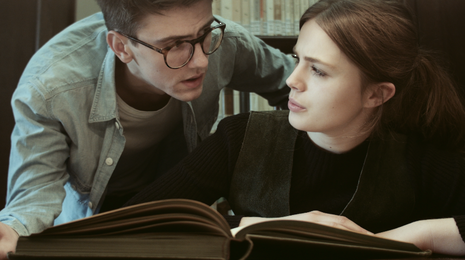Preview: A pleasant term with Wenlock & Jones
Allanah Lewis gets a Memebridge-approved sneak peak at the rest of the series, and finds remarkable perception behind its jovial premise.

“There’s always some drama happening in Raleigh.” Raleigh College, Cambridge. Small, central, and ancient. The first to introduce dental dams into their fresher’s packs. But their precious mascot, a statue of Justinian the sheep-dog, has been stolen in broad daylight, along with Henry’s bike, Diana – and how will Henry get to his lectures now, when he lives 6 miles away from town in the brutalist shit-hole, Keynes? The mystery leads our protagonists, Genie Jones and Henry Wenlock, on a scavenger hunt around this pseudo-town, from the Cambridge Union to the Christian Union, past boaties and thesps to CUSU hopefuls.
As the list of suspects begins to increase, so too do the questions: who in Cambridge might have a vendetta against a statue of a bronze dog? What exactly went down that night at Raleigh formal? Is choir really just a One Direction conspiracy?
“Everything is turned up a notch: the eccentricities are more eccentric and the deadlines are more dire.”
Quite simply, Wenlock and Jones is very enjoyable. It’s funny without being too parodical, charming without being childish. Each episode is well-cut and picks up stylishly where the last left off. The musical score is a clever ode to Sherlock, and the camera work is generally excellent, though nauseatingly bumpy in the first episode.
While writing only began in March last year, the idea of having a sequential show over the course of a term at Cambridge has been toyed with by the writers/director (Yaseen and Cassia) for a lot longer. The timing seems to have worked in their favour. Having wrapped up at the end of Lent, this makes for the perfect Easter term supplement. We begin to tire of the old “exams aren’t everything” diatribe when all around us are losing their heads (and we’re having trouble keeping ours).
For me at least, Wenlock & Jones parcels up just how I feel when I move back to this bizarre city for two months at a time: we can't all make every 9am, change degrees six times, and be part of every society. Some just scrape along week by week. Some don’t even manage that.
When I meet Cassia and Yaseen, I ask them about their influences. “Edgar Wright,” says Yaseen. “It’s all Edgar Wright.” That much is plain to see. They agree almost all young film-makers cite Wright as a source of inspiration and guidance: the quick pace, the compact narrative, the visual over the verbal. While Yaseen prefers American comedy, Cassia is drawn to the British. “We sort of promised each other that we would watch a show each, so we’d kind of swap: ‘here are my influences, here are yours.’” The end result is a marriage of Jonathan Creek with When Harry Met Sally (well, up until Harry and Sally sleep together).
The semi-platonic relationship between Wenlock and Jones is certainly endearing, as is the general verisimilitude of this alternative Cambridge. Cassia and Yaseen appear to have had a lot of fun with world-building, having put off writing to come up with new names for each undergraduate college. “It had to be alternative” Cassia says, “because everything is turned up a notch: the eccentricities are more eccentric and the deadlines are more dire”. The fantastic meets the painfully real. Stereotypes are blown up, relationships are exaggerated.
As much as it dwells on anxiety and despair, it isn’t hopeless. No one wants to watch a show about the mundanity of their own lives, yet that is exactly what Wenlock & Jones tentatively offers.
The show took me aback with its accuracy, commenting on the inexplicable nature of anxiety better than any student journalism I have read: “This place crushes kids' spirits. Smart kids, good kids, they end up so sad and anxious.”
The Cambridge of Wenlock & Jones is not so different from that in which I live for six months of a year. Although the touching punchline comes in the form of a ‘Cambridge is the people, not the degree’ sententia (which, of course, we’ve heard enough of from parents, friends, graduates), it does seem to sink in here
 News / Eight Cambridge researchers awarded €17m in ERC research grants27 December 2025
News / Eight Cambridge researchers awarded €17m in ERC research grants27 December 2025 News / News in Brief: carols, card games, and canine calamities28 December 2025
News / News in Brief: carols, card games, and canine calamities28 December 2025 News / Caius mourns its tree-mendous loss23 December 2025
News / Caius mourns its tree-mendous loss23 December 2025 News / Clare Hall spent over £500k opposing busway 24 December 2025
News / Clare Hall spent over £500k opposing busway 24 December 2025 Interviews / Meet Juan Michel, Cambridge’s multilingual musician29 December 2025
Interviews / Meet Juan Michel, Cambridge’s multilingual musician29 December 2025








